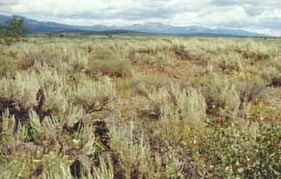 Camas Meadows
Camas Meadows Camas Meadows
Camas MeadowsThe morning air was extremely chilly and crisp and the horses rank, so that what was an orderly gallop, at first, soon developed into a race. After half an hour of this we approached a ridge, which was the first roll of the foot-hills.
The first ones to make the summit of the ridge suddenly stopped and then quickly returned to the foot, as the rest of us came up we soon learned that the Indians had made a stand just over the ridge. We dismounted, and the Number Fours, each holding four horses, being unable to fight, left about thirty-five of us to meet the Indians. Brawling to the top we saw a line of dismounted skirmishers, standing behind their ponies, on open ground and about a thousand yards away. We deployed along the ridge, and for twenty minutes or so exchanged shots with them with but little damage on either side, as the range was long for our Springfields and longer for their Winchesters. Lieutenant Benson of the 7th Infantry, who was attached to our company for the day, standing up for an instant, just at my side, received a bullet which entered at the hip-pocket and went out at the other, having passed entirely through both buttocks; this, while we were facing the enemy, caused us to realize that we had no ordinary Indians to deal with, for while we had been frolicking with the skirmishers in front, Chief Joseph had engineered as neat a double flank movement as could be imagined, and we were exposed to a raking fire coming from right and left. The horses had been withdrawn, more than five hundred yards, to a clump of cottonwoods; and when we turned around there was no sight nor sign of them. For a brief period there was a panic, and then we heard the notes of a bugle blowing "Recall' from the cottonwood thicket. The race to that thicket was something never to be forgotten, for a cavalryman is not trained for a five hundred yard sprint; luck was with us, however, and no man was hit in that mad race for safety. I had a horse's nose-bag slung over my shoulder containing extra cartridges, and a bullet cut the strap and let it fall to the ground. A hero would have stopped, gone back and recovered that bag, but not 1. We all reached the horses and found the place an admirable one for defence; it was a sort of basin, an acre or so in extent, with a rim high enough to protect our horses, and filled with young cottonwoods in full leaf It was oval in shape, and we deployed in all directions around the rim.
Sgt. H.J. Davis
While exchanging with the hidden enemies, drawing their minds to us, a few good-shot warriors are crawling on them from another part of the hill. Now shots are heard from that direction. Those soldiers become scared. A bugle sounds down in the cottonwoods. These soldiers run like deer for the shelter brush.
Wottolen
For two hours it was a sniping game and our casualties were eight. The Indians crawled very close, one shooting Harry Trevor in the back at about fifteen feet, as we knew by the moccasin tracks and empty shells found behind a rock after the engagement. Poor Trevor's wound was mortal as was that of Sam Class, who was shot through the bladder, a bullet hit Sergeant Garland's cartridge-belt and drove two cartridges from it clean through his body, his wound never healed and he blew his brains out a few years later ... This was the amount of damage done to us, and what we did to the Indians we never knew, as they retreated in good order taking their dead or injured with them, after they found they could not dislodge us. Three dead ponies and some pools of blood were all the records we found of their casualties.
Sgt. H.J. Davis
Soon all shooting stopped. The soldiers could not be driven from the woods and the captured herd now out of danger, we left for camp.
Wottolen
I could never understand how those two companies of the Ist Cavalry could have missed the Indians and gotten entirely out of touch with us, when we started together and we were fighting within half an hour and kept it up for nearly three hours.
Sgt. H.J. Davis.